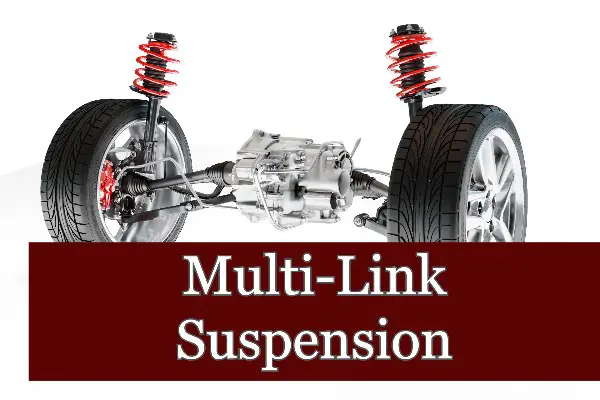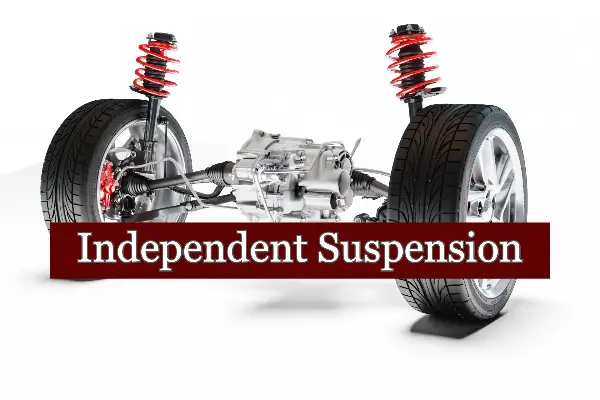Have you ever found yourself grappling around to choose between a multi-link or an independent suspension? Even though multi-link suspension is also a type of independent suspension, there are some core differences between multi-link suspension and other independent suspension.
This ultimately raises the multi-link suspension vs independent suspension debate. Now, if your answer to the first question is yes, this is the right place to clear all your confusion and get the right direction.
Let’s delve into the differences between multi-link suspension and independent suspension, exploring their respective characteristics, performance capabilities, and real-world applications.
What is Multi-link Suspension?

Multi-link suspension is a sophisticated type of suspension system commonly used in high-performance and luxury vehicles. It is designed to provide superior handling, stability, and comfort on the road. The key feature of multi-link suspension is its ability to independently control each wheel’s movement and adapt to different driving conditions.
This suspension system consists of multiple arms or links that connect the wheels to the chassis. Each arm is attached to the wheel hub at one end and connected to the body or subframe at the other end using various types of bushings or bearings.
Related: Is A Double Wishbone Better Than Multi-Link Suspension?
What is Independent Suspension?

Independent suspension is a type of suspension system that allows the wheels on each side of the vehicle to move independently of one another. Instead of relying on a solid axle connecting both wheels, the independent suspension uses multiple control arms, links, or struts to connect each wheel separately to the chassis. This design offers several advantages over traditional solid axle suspensions.
In an independent suspension system, each wheel is attached to its control arm or wishbone. These arms are connected to the vehicle’s chassis through various components such as ball joints and bushings.
This arrangement allows the wheels to travel vertically in response to bumps or uneven surfaces without affecting the other wheels. As a result, vehicles equipped with independent suspension can maintain better contact with the road surface at all times, leading to superior handling characteristics.
Read also: Dependent Vs Independent Suspension System
Multi-link Suspension vs Independent Suspension
While both multi-link and independent suspension systems aim to optimize comfort and control, they do so in distinct ways. As an advanced variant, the multi-link suspension also has some improvements that ultimately point out some notable differences in various aspects. Let’s check those below:
Construction
The multi-link suspension consists of multiple control arms that are connected to the wheel hub, creating a complex system that enables each wheel to move independently.
This design allows for precise control of suspension settings and excellent ride quality. The construction involves using a combination of steel and aluminum alloy components, strategically positioned to optimize handling and minimize weight.
On the other hand, independent suspension typically utilizes a single control arm per wheel, which contributes to a simpler construction compared to Multi-link Suspension. However, it may compromise slightly on overall performance.
In terms of materials used in independent suspension systems, they commonly employ steel or aluminum alloy components as well. Steel offers durability and strength but adds weight, while aluminum alloys provide lightweight advantages without compromising structural integrity.
Overall, Multi-link Suspension demonstrates a more intricate construction that grants superior handling capabilities and ride comfort due to its independently moving wheels.
Performance in Different Driving Conditions
In terms of performance in various driving conditions, Multi-link Suspension excels in dynamic situations like aggressive cornering or sudden lane changing. Its ability to maintain optimal tire contact with the road surface provides enhanced grip and responsiveness.
Both Multi-link and independent suspensions offer comparable levels of comfort when it comes to performance during city driving and on smooth tarmac roads.
However, off-road enthusiasts would lean towards vehicles with independent suspension as it provides increased articulation and flexibility over rough terrains while maintaining optimal tire contact with the ground. This aspect becomes particularly advantageous when encountering obstacles that require wheels to react independently for enhanced traction.
To summarize, while both Multi-link suspension and independent suspension excel in different driving conditions, Multi-link offers superior road-holding abilities for spirited driving on paved surfaces, while independent suspension shines in off-road scenarios through its ability to flexibly adapt to uneven terrains ensuring constant tire-ground connection.
Ride Quality
Multi-link Suspension generally outperforms Independent Suspension in terms of ride quality due to its enhanced stability and control. The improved system geometry allows for better resistance against body squatting and nose-diving under acceleration or braking scenarios.
However, when it comes to pure comfort on smooth roads or highways, Independent Suspension may have a slight advantage as it absorbs road imperfections more effectively compared to Multi-link Suspension.
It is worth noting that factors such as dampers’ tuning (shock absorbers), tire choice, overall vehicle weight distribution, and additional suspension components also contribute significantly to overall ride quality and comfort
Durability
Multi-link suspension generally offers better reliability and longevity compared to independent suspension systems. This is primarily due to its superior ability to distribute forces evenly across the vehicle’s chassis and absorb impact from various road surfaces.
The multiple links in Multi-link suspension provide enhanced stability and control, minimizing stress on individual components and reducing wear.
Moreover, Multi-link suspensions tend to have fewer moving parts compared to independent suspensions, resulting in a lower likelihood of mechanical failure over time. The reduced complexity often translates into decreased maintenance requirements, making Multi-link suspensions more cost-effective in the long run.
However, the durability of both types of suspensions can vary significantly based on manufacturers’ implementation. Factors such as the quality of materials used, engineering precision, regular maintenance, driving conditions, and vehicle weight also greatly influence their overall durability.
Compatibility
Multi-link suspensions are commonly found in luxury sedans such as BMW 7 Series, Mercedes-Benz S-Class, Audi A8, and Lexus LS. These vehicles benefit from Multi-link suspensions as they deliver superior ride comfort while maintaining exceptional cornering abilities during spirited driving.
In contrast, independent suspension can be found on a wide range of vehicles including popular models like Honda Civic, Toyota Camry, Ford Escape, Jeep Wrangler, and Volkswagen Golf. The versatility of independent suspension makes it well-suited for everyday commuting as well as tackling diverse terrains or providing agile handling on twisty roads.
Cost
Multi-link Suspension is often considered a more advanced and sophisticated independent suspension system compared to other options. Due to its complex design, which involves multiple control arms and linkages, Multi-link Suspension systems tend to be more expensive than simpler independent suspension setups.
Additionally, since Multi-link Suspension is often found on high-end or luxury vehicles where premium driving characteristics are emphasized, manufacturers often opt for more expensive materials and advanced technologies when constructing these suspensions.
Pros and Cons of Multi-Link Suspension
While the pros of multi-link suspension certainly shine with its superior handling, stability, and improved ride comfort, it’s equally important to acknowledge the cons too. Let’s check them both to get a comprehensive understanding.
Pros:
- Provides excellent control during cornering, minimizing body roll and ensuring optimal traction on uneven surfaces.
- By isolating each wheel’s movements from the others, it effectively absorbs road shocks, bumps, and vibrations, resulting in a smoother ride quality for occupants.
- With its ability to allow more precise adjustment of various alignment settings such as camber, toe-in, or toe-out angles, multi-link suspension enables better steering response and exceptional maneuverability.
- Contributes to enhanced braking performance by maintaining consistent tire contact with the road surface even under hard braking or emergencies.
- By eliminating the need for additional components such as anti-roll bars or complicated linkages used in other suspensions like double-wishbone or MacPherson strut systems, multi-link suspensions help reduce the overall weight of the vehicle while still providing excellent handling characteristics.
Cons:
- May require more frequent maintenance due to its increased complexity. Additional parts mean more potential points of failure which may necessitate regular inspections and repairs throughout the lifespan of the vehicle.
- The initial cost of installing a multi-link suspension system can be higher than some other types of independent suspension.
Pros and Cons of Independent Suspension
When it comes to understanding independent suspension, knowing both the pros and cons is crucial for making informed decisions. So, let’s focus on the pros and cons of this suspension as well.
Pros:
- Excels at isolating vibrations from the road surface, thereby greatly enhancing ride comfort for occupants.
- Provide precise traction control by enabling wheels on one side of the vehicle to maintain optimal contact with the road even when the opposite side encounters a bump or uneven terrain.
- Increased ground clearance, which allows vehicles equipped with independent suspensions to traverse uneven terrains more effectively without causing damage or impairing maneuverability.
- Independent suspensions boast a lighter construction compared to traditional multi-link variants.
Cons:
- Replacing damaged parts within an independent suspension system can be more expensive.
- Limited underbody space is available for larger vehicles equipped with independent systems due to their design characteristics.
Final Words
When it comes to choosing between multi-link suspension and independent suspension for your vehicle, the decision ultimately depends on your driving preferences and vehicle requirements. The multi-link suspension offers better handling and stability, particularly in high-speed conditions and during cornering.
On the other hand, independent suspension provides a smoother ride over uneven terrain, making it ideal for off-road adventures or driving on bumpy roads.
So, if you prioritize performance and precision in your driving experience, multi-link suspension may be the way to go. Its ability to maintain tire contact with the road surface ensures enhanced traction and control, especially when navigating tight turns or challenging road conditions.
However, if comfort and versatility are more important to you, independent suspension might be the better choice. Its ability to absorb shocks and vibrations results in a more comfortable ride for daily commuting or long-distance trips. Ultimately, consider your driving needs and preferences before deciding between these two advanced suspension systems.